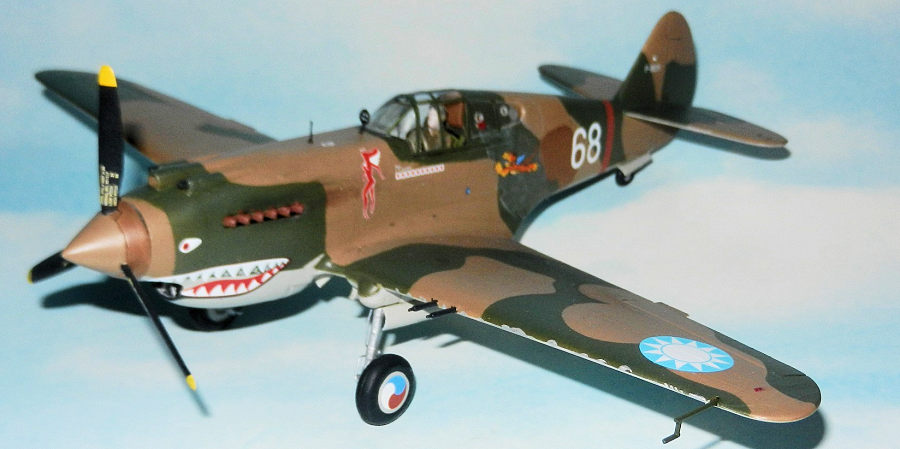
| KIT #: | 85-5209 |
| PRICE: | CAD$37.00 |
| DECALS: | Two options |
| REVIEWER: | Pablo Calcaterra |
| NOTES: | Sky Models 48047, Cutting Edge 48255 and Kits World 48058 decals |

| HISTORY |
Charles Herman Older was born in
Hanford, California on September 29, 1917. Raised in the Los Angeles area, Chuck
Older graduated from Beverly Hills High School. He was student body
president, active in several sports and an Eagle Scout. He studied
political science at U.C.L.A. On day he paid $ 5.00 to take a 30 minute flight
in an Emsco open cockpit, mid-wing monoplane. Certainly this started his hunger
for the air. While still in campus a Lt.(JG) Naval Aviator in full uniform with
gold wings showed up. He was recruiting cadets for naval aviation. Older put
both things together (the early ride and the Navy man) and he decided to join
the Navy as a pilot. He later on said that “The uniform and gold wings, together
with all the talk of hammerhead stalls, snap rolls, chandelles, carrier
landings, dive bombing and tight formations proved irresistible” . Upon
graduation with a major in political science he reported to Long Beach,
California for elimination flight training. He passed first in his class and
then reported to Pensacola as a Marine Cadet. He earned his wings on April 1,
1940. Now
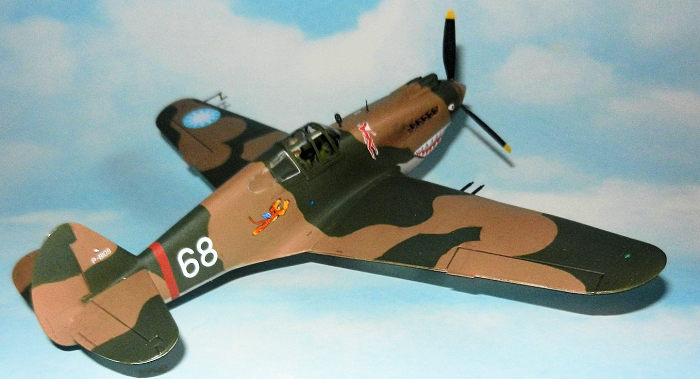 a Second
Lieutenant Older served with the First Marine Aircraft Group, Quantico,
Virginia. Upon arrival at Quantico he was assigned to Fighting Squadron One
under the command of Major T. J. Walker. The Group Commander was Col. Field
Harris. VMF-1 was equipped with Grumman F3F-2’s. The summer of 1940 was spent in
intensive training at Quantico. All summer long the pilots devoured the reports
of the Battle of Britain. The First Marine Aircraft Group, following carrier
qualification of the Wasp off Norfolk, was ordered to Guantanamo, Cuba. For the
next seven months the Group lived in tents on a hill overlooking McCalla Field,
except for brief stays in St. Thomas, San Juan, and aboard Wasp and Ranger on
maneuvers. It was during our stay in Guantanamo that the pilots heard rumors of
American pilots flying for the Dutch in Java and even some rumors of Americans
in China. Upon returning to Quantico in the Spring of 1941 they started to take
delivery of new F4F’s at Floyd Bennett Field on Long Island. The F4F was an
improvement over the obsolete F3F’s in both performance and firepower, but he
didn’t like its ground handling characteristics.
a Second
Lieutenant Older served with the First Marine Aircraft Group, Quantico,
Virginia. Upon arrival at Quantico he was assigned to Fighting Squadron One
under the command of Major T. J. Walker. The Group Commander was Col. Field
Harris. VMF-1 was equipped with Grumman F3F-2’s. The summer of 1940 was spent in
intensive training at Quantico. All summer long the pilots devoured the reports
of the Battle of Britain. The First Marine Aircraft Group, following carrier
qualification of the Wasp off Norfolk, was ordered to Guantanamo, Cuba. For the
next seven months the Group lived in tents on a hill overlooking McCalla Field,
except for brief stays in St. Thomas, San Juan, and aboard Wasp and Ranger on
maneuvers. It was during our stay in Guantanamo that the pilots heard rumors of
American pilots flying for the Dutch in Java and even some rumors of Americans
in China. Upon returning to Quantico in the Spring of 1941 they started to take
delivery of new F4F’s at Floyd Bennett Field on Long Island. The F4F was an
improvement over the obsolete F3F’s in both performance and firepower, but he
didn’t like its ground handling characteristics.
About this time a retired Navy Commander recruiting for the American Volunteer Group came to Quantico. Ken Jernstedt, Tom Haywood, and Older all from VMF-1, decided to join the AVG. The procedure was first to go to New York and sign a one-year contract with Central Aircraft Manufacturing Company and then to submit their resignations through the squadron. In late July, 1941, they left the Marine Corps and proceeded to Los Angeles where they would meet with others and receive instructions to travel to Burma. On August 26, 1941 the group finally sailed from Los Angeles on the Dutch passenger cargo ship, “Zaandam.” (sic) They told their families that they were going to China to help train Chinese pilots in their war against Japan.
They reached Rangoon on October 9, 1941 and the following day they took a train for Toungoo, about 175 miles northeast of Rangoon. Older was put in charge of the 3rd Squadron, the Hell’s Angels (inspired by the classic aviation movie about WWI).
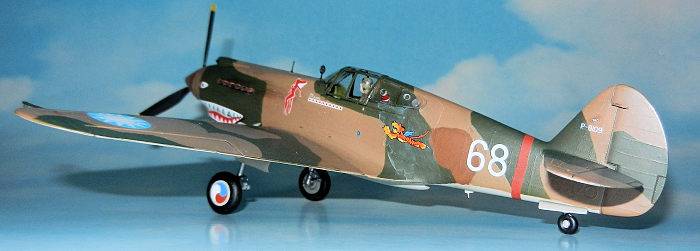 At Toungoo
every AVG pilot received daily training from Claire Chennault starting at 6:00
AM. These were focused in the tactics required to defeat the Japanese using
their P-40’s.
At Toungoo
every AVG pilot received daily training from Claire Chennault starting at 6:00
AM. These were focused in the tactics required to defeat the Japanese using
their P-40’s.
On December 12, 1941 his Squadron flew to Rangoon to join the R.A.F. in the defense of the southern end of the Burma Road. The first of the large scale air battles occurred on December 23.where he downed two enemy aircraft. He fought two days later in the famous Christmas Day air battle downing three more Japanese planes and becoming an ace. Before the Flying Tigers were officially disbanded on July 4, 1942, he would add 5.25 more victories to become a double ace and the third highest scoring ace of the AVG with 10 kills.
After the AVG was disbanded, he returned to the United States, got married with Catherine Day, and after a few months of flying B-24’s at Consolidated Aircraft in San Diego and Tucson, was commissioned in the US Army Air Corps as a Captain. He was given command of a P-38 operational training squadron in California where recently commissioned pilots were given 120 hours of fighter tactics, gunnery and related training before being sent overseas in combat.
In the Spring of 1944 he requested re-assignment to the 23rd Fighter Group of the 14th Air Force in China. He arrived back in China in June, 1944. He was first assigned as Group Operations Officer and later Deputy Group Commander. The 23rd Fighter Group Commanders during his second tour were his fellow former AVG Tex Hill and Ed Rector. Older was promoted to Major and shoot down another eight Japanese aircraft. The most memorable mission during his second combat tour was one in which Olsen led the 118th Tactical Reconnaissance Squadron on the first strike on Japanese-held Shanghai in January, 1945. Joining up with aircraft from the 74th Squadron, 16 P-51 Mustangs simultaneously attacked three airfields at Shanghai and destroyed 72 Japanese aircraft on the ground and 5 in the air without the loss of any of the attacking aircraft. By the end of the war, he had been promoted to Lieutenant Colonel.
After the war Chuck Older remained in the Air Force Reserve and flew Douglas B-26’s as a “weekend warrior.” He then entered law school at the University of Southern California in 1949. At the end of his first year (1950) he was recalled to active duty for the Korean War with the 452nd Bomb Wing flying B-26’s. He was assigned to Wing Operations. After training for sixty days in California, the aircraft were flown to Japan. He flew Douglas B-26 Invaders in the Korean War.
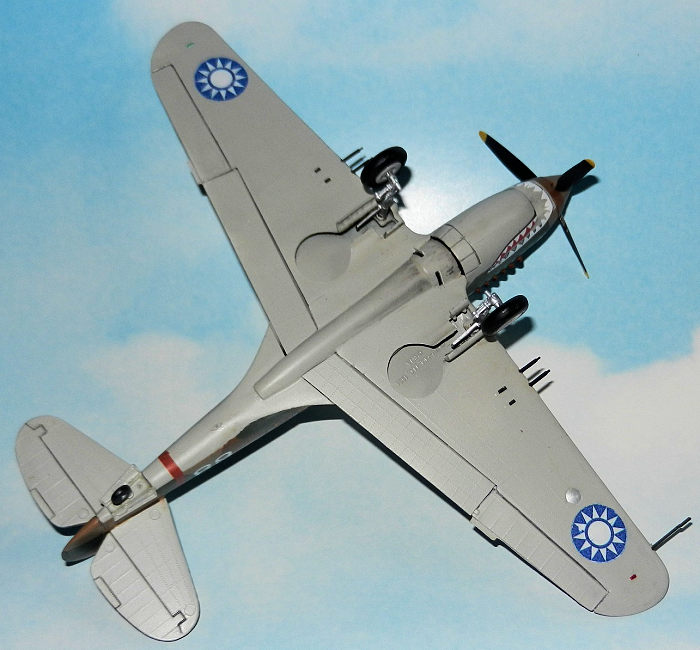 When he
returned to the US Olsen graduated from University of Southern California law
school in 1952. Olsen became a partner in a law firm in Los Angeles,
specializing in aviation and civil trial work. After a distinguished legal
career, he was appointed to the bench of the Los Angeles Superior Court
by Governor Ronald Reagan in 1967. His most famous case was the Charles Manson
trial. The trial lasted 10 months, the longest in American history at the time.
Prosecutor Vincent Bugliosi praised Older for his firm but fair handling of the
difficult case. At one point, Manson tried to attack the judge and had to be
restrained by bailiffs. Older served for 20 years before retiring.
When he
returned to the US Olsen graduated from University of Southern California law
school in 1952. Olsen became a partner in a law firm in Los Angeles,
specializing in aviation and civil trial work. After a distinguished legal
career, he was appointed to the bench of the Los Angeles Superior Court
by Governor Ronald Reagan in 1967. His most famous case was the Charles Manson
trial. The trial lasted 10 months, the longest in American history at the time.
Prosecutor Vincent Bugliosi praised Older for his firm but fair handling of the
difficult case. At one point, Manson tried to attack the judge and had to be
restrained by bailiffs. Older served for 20 years before retiring.
On June 17, 2006, he died at the age of 88 of complications from a fall in his home in West Los Angeles. He was survived by his wife and three daughters.
Chuck Older received the Distinguished Flying Cross with two Oak Leaf Clusters, Air Medal with two Oak Leaf Clusters, Bronze Star, British Distinguished Flying Cross, Chinese Air Force Medal and the Order of the Cloud Banner.
| THE KIT |
The old and venerable Revell kit has been around before I was born. Until the issue of the Airfix kit it was the most accurate kit. The shortcomings are as follows: wrong instrument panel (for the E model), nun hat area close the radiator is too wide, there is nothing inside the main landing gear wheels. There are also several details missing that we will describe during the description of the build.
Decals are glossy but pixelated. The CAF roundels are too large, the Squadron fuselage band is an incorrect yellow (actual ones were white, light blue or red).
| CONSTRUCTION |
This was my son’s Lucas first 1/48th
kit. Since he was 8 or so he wanted to build a “shark mouthed” plane. I bought
him the Revell kit 3 years ago and in the meantime he built Matchbox’s Zero and
Airfix Spit V painting the using brushes. But this was going to be his first kit
with the use of Tamiya putty and airbrush. That really increased his level of
engage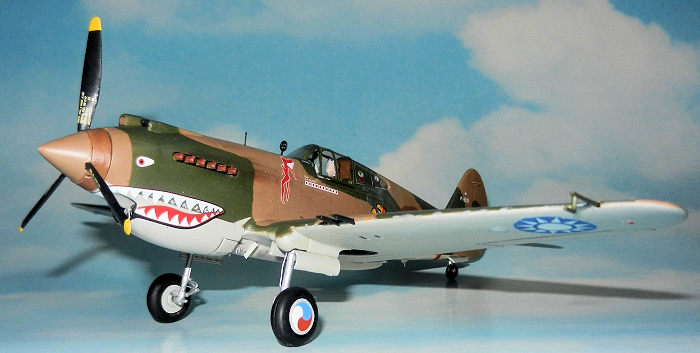 ment
on this project. So while I was working on the Airfix kit in 1/48 Lucas was
working on his Revell.
ment
on this project. So while I was working on the Airfix kit in 1/48 Lucas was
working on his Revell.
He carefully painted the pilot. Used a copy of the instrument panel of the Hobbycraft version I had made using 2 part epoxy on plaster of Paris. He painted the interior of the cockpit, glued the different boxes that had been painted in black. With a brush and Rust colour he painted the exhausts that I had previously improved using a small drill to open the holes. He attached these to the fuselage halves, put the propeller together and glued the floor, seat with pilot, stick. He closed the fuselage halves and used putty and sandpaper to improve the union of both halves. He did a fantastic job. He even re-scribed the panel lines that had been erased while sanding the putty.
From the Trumpeter kit I had made a copy of the nun hat. I helped him here and replaced the too stubby Revell one with my 2 part epoxy copy. Lucas glued the wings together and carefully attached them to the fuselage. There was some putty needed around the border of attack but none was required on top of the wings/fuselage union.
He added the knuckles that also needed some Putty and sandpaper. Tail planes were next. Lucas covered the cockpit and “Captain Kibbles” (as he called the pilot) with wet tissue paper and the plane was ready for a coat of ModelMaster white premier to check for imperfections. He did a couple of little ones here and there and then we were ready for the painting.
| COLORS & MARKINGS |
As Lucas does not have a face mask we went to the backyard with the air compressor, the airbursh, the colours…a significant move out to paint my plane and his at the same time. We started with the underwing colours (ModelMaster 4693). Once this colour was dry Lucas masked the undersides with paper and Tamiya tape.
We painted our kits using ModelMaster 4709 for the first colour of the top sides. We gave our kits a light coat of heavily diluted ModelMaster 4711. I proceeded to cut Tamiya tape to mask both kits. He did not feel like doing this part himself…and also asked me to give the plane the coat of green (his engagement was not that high at the moment…the project was taking too long).
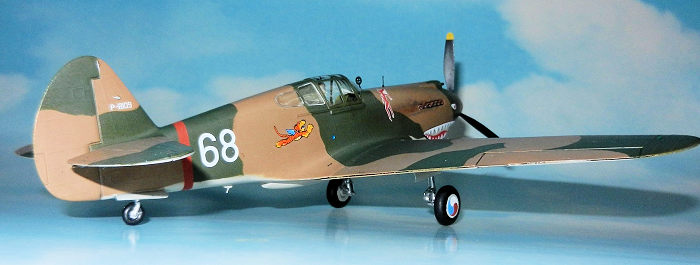 Once I
painted the green part of the fuselage using ModelMaster 4726 his interest
picked up again seeing how nice the plane looked with the smooth finish given by
the airbrush compared to his 2 previous kits painted with an ordinary brush. So
we proceeded to highlight the moveable surfaces with a very sharp black pencil,
exhausts with drybrushed black and rust pastels. The retouches of brown around
the propeller hub and the fuselage were painted using a brush and ModelMaster
4706.
Once I
painted the green part of the fuselage using ModelMaster 4726 his interest
picked up again seeing how nice the plane looked with the smooth finish given by
the airbrush compared to his 2 previous kits painted with an ordinary brush. So
we proceeded to highlight the moveable surfaces with a very sharp black pencil,
exhausts with drybrushed black and rust pastels. The retouches of brown around
the propeller hub and the fuselage were painted using a brush and ModelMaster
4706.
I sprayed Future to get the kit ready for the decals. Using a combination of Airfix stencils and Kits World and Sky Models decals Lucas dressed up the kit. I made a copy of the angel on the left side (inkjet printer and white decal paper) and he glued it on place giving the plane 2 angels. And here comes the contribution to the modeling world: looking closely at one of the pictures of the sequence taken by RT Smith over China I found out that the top of the right wing does not have the CAF roundel. After discussing and consulting with Mr. Terrill Clements we were able to confirm this fact that, as far as I know, has been misrepresented in profiles and other built kits. So we did not put the CAF roundel on the top of the right wing. The bottom wing roundels are a copy made with our Inkjet printer and white paper decal (we are running low of stock of CAF roundels for the AVG planes…). In my box of spare decals I found a couple of round black dots to represent the pupils of the red eyes. Lucas drybrushed grey paint to represent the worn out paint around the top teeth.
| FINAL CONSTRUCTION |
I gave the kit a spray of ModelMaster clear satin. When
dry then added the following items that are missing in the kit and that I
scratchbuilt: the horn for the left side of the top of the rudder, the cable
under the tail surface
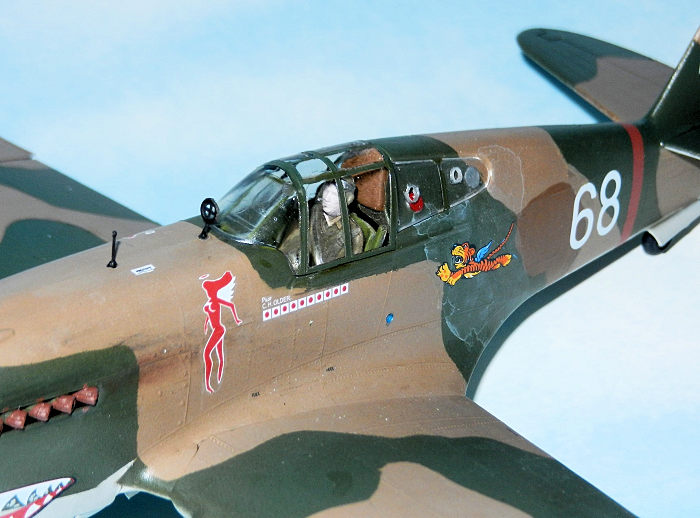 on the
right side, the little exhausts on the bottom of the back of the fuselage, the 3
oil vents close to the radiator exit. I painted the position lights (wings in
clear red and green over a base of aluminum, fuselage in blue, tail in white).
Lucas attached the landing gear,
the landing gear doors, the wheels, the pitot tube.
on the
right side, the little exhausts on the bottom of the back of the fuselage, the 3
oil vents close to the radiator exit. I painted the position lights (wings in
clear red and green over a base of aluminum, fuselage in blue, tail in white).
Lucas attached the landing gear,
the landing gear doors, the wheels, the pitot tube.
The clear parts are very defective: the windshield for the open cockpit version was undershot, same as the back right window for the closed version. So Lucas had no option but to (after all the hard work in the cockpit and “Capt. Kibbles”) display the plane with the closed cockpit using the back window from the open cockpit version…I helped him by drilling the two holes to access the fuel tanks on the left back windows. I scratchtbuilt for him the armoured glass and the reflective gunsight. I added the brake lines made with wire and painted in aluminum. Finally Lucas attached the post and bead gunsight (previously painted in black) and his “68” was finished.
| CONCLUSIONS |
I am very proud that Lucas took the time, had the patience and was very attentive to details to try to build the plane as close as possible to the original subject. He even sometimes pushed to make things better though I had told him that what he had done was good enough…but it was not good enough for him!
His plane turned out so good that it proudly shares the shelf along with my 4 AVG P-40s.
14 December 2018
Copyright ModelingMadness.com
If you would like your product reviewed fairly and fairly quickly, please contact the editor or see other details in the Note to Contributors.
Back to the Main Page Back to the Review Index Page Back to the Previews Index Page